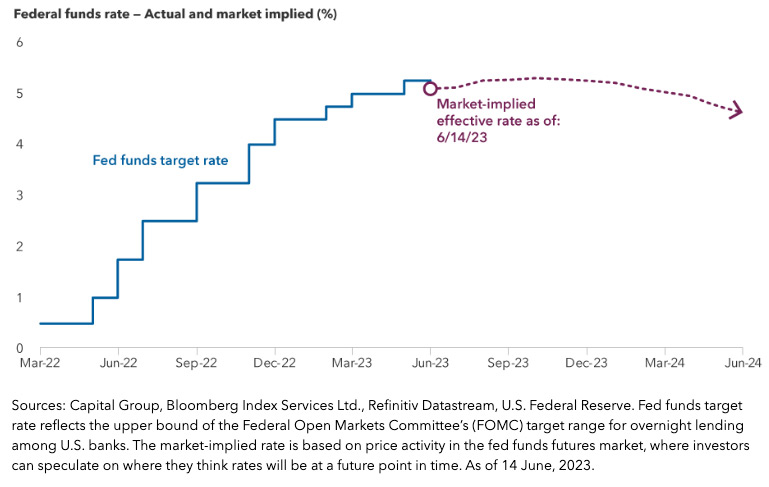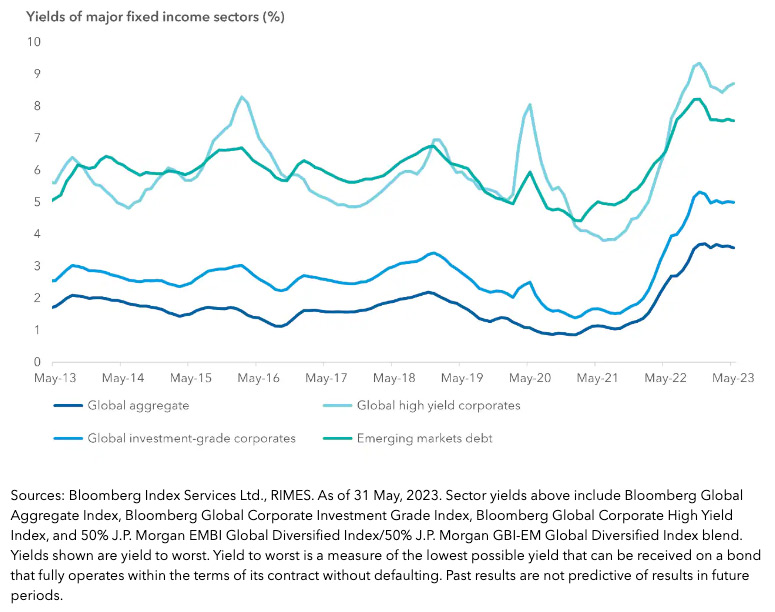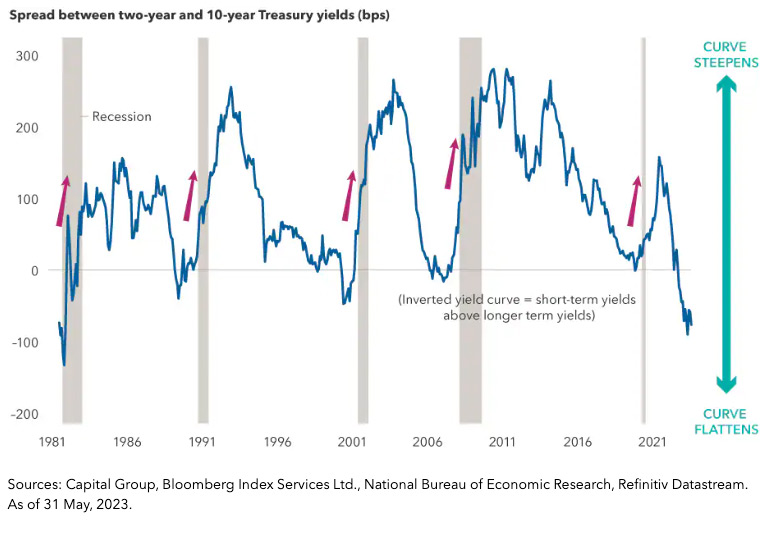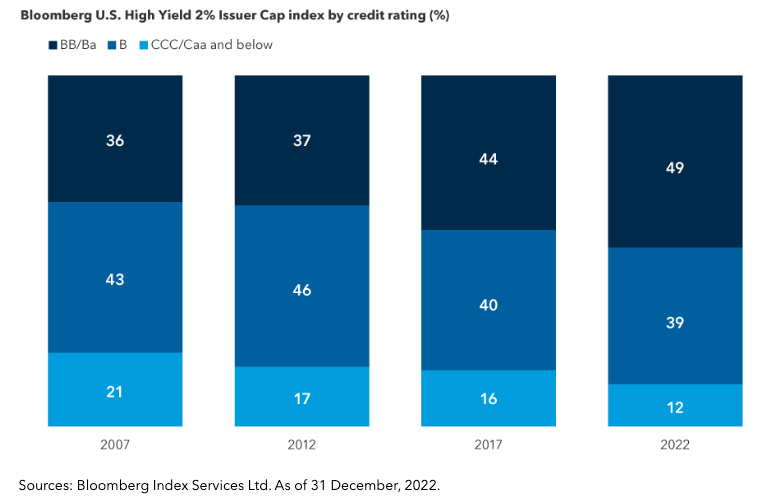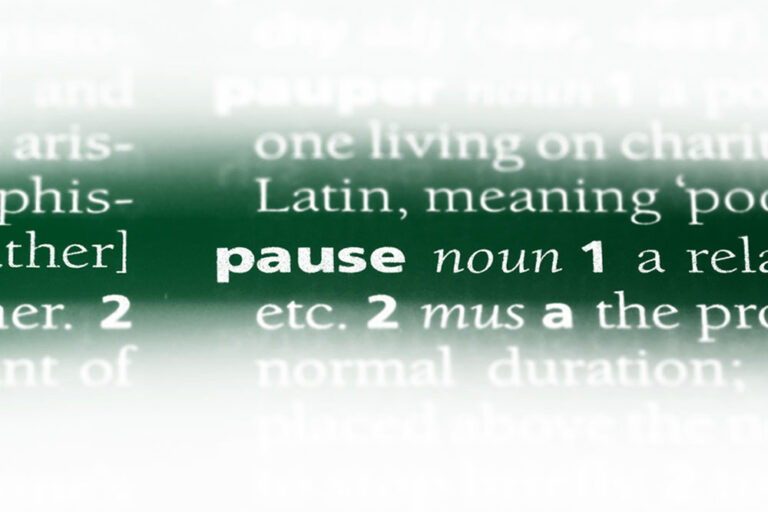
Bonds today provide a sensible option to the dilemma facing investors — what to do as markets ricochet between hopes of a soft landing and concerns of a recession? After a rough 2022, fixed income is back to fulfilling its role as a source of stability and diversification.
Meanwhile, the Federal Reserve did its best to keep investors guessing. At its June meeting, policymakers kept the benchmark interest rate unchanged at a range of 5.0% to 5.25% but left the door open for further hikes amid robust labour markets data and persistent inflation. Central bankers expect to end the year at a rate of 5.60%, implying two additional hikes.
Markets have had to repeatedly readjust expectations as a resilient consumer pushed the Fed to lift rates — ostensibly raising the stakes for a recession. In the bond world, that suggests higher income potential and new opportunities.
Pause, skip or pivot? Investors expect interest rates to decline
“The possibility of the US falling into a recession over the next year remains elevated as the consequences of the Fed’s aggressive rate hiking campaign make their way through the economy,” says Pramod Atluri, fixed income portfolio manager. Pausing gives the Fed a chance to see the impacts of higher borrowing costs and tighter lending conditions.
Also read: Delivering Income is Back
Despite expectations of a relatively mild recession, there is a lingering sense that investors are waiting for the next shoe to drop. Money market funds have ballooned to a record $5.2 trillion as investors flocked to cash. At the same time, bonds have posted moderate gains for the year-to-date period ended 13 June, 2023.
One reason behind the run-up is that inflation has declined from last year’s peak and may be on a sustained downward path. “If the economy slows further as an outcome of tight monetary policy and restrained bank lending, it should help maintain that trend and pull inflation down closer to the Fed’s 2% target range,” explains Atluri.
An income ride that offers some shock absorbers
The upshot to higher rates is higher income. The Bloomberg Global Aggregate Index, a widely used benchmark for investment-grade (BBB/Baa and above) bond markets, yielded 3.7% on 14 June, 2023, compared to a rate of 1.3% on 31 December, 2021. Unlike previous upticks we’ve seen over the past 10 years, yields have stabilised at these elevated levels across fixed income sectors. This indicates that strong income may finally persist after decades of low rates and a very painful 2022.
Strong income may persist as bond yields stabilise at elevated levels
Higher rates also mean that bonds are better prepared to absorb price or interest rate volatility, making it easier to post positive returns. The total return of a bond fund consists of distributions, price changes and interest paid. Today’s higher interest essentially provides more of a buffer against volatility.
What’s more, if growth deteriorates or out-of-the-blue crises appear, high-quality bonds tend to provide the important benefit of diversification from equities. Here’s why: These events often spur a flight to US Treasuries, which in turn positively impacts bond prices as yields begin to fall. Likewise, yields would fall if the Fed steps in to support growth via rate cuts.
On that front, an inverted yield curve has implied the potential of recession for some time. As the Fed began lifting rates in March 2022, interest rates on two-year Treasuries rose higher than rates on the 10-year. This yield curve inversion ignited an especially animated discussion among Capital Group’s Fed watchers as to whether the economy will enter a downturn.
Recession risks present opportunities in yield curve positioning
For investors, increasing exposure to interest rates now may offer an attractive combination of meaningful diversification and total return potential, Atluri says. If the economy weakens, short-term Treasury yields may drift lower, particularly if Fed rate cuts are more likely. Meanwhile, longer term Treasury yields could remain anchored or even rise. These movements would cause the yield curve to steepen from its current deeply inverted state.
Steady consumer spending
Consumers continue to flex their spending power, which has helped keep companies’ balance sheets relatively strong. For the most part, companies have sufficient cash to fund operations and growth plans.
The premium investors pay over Treasuries to hold investment-grade or high-yield bonds, or spreads, are wider today compared to their levels prior to the current hiking cycle. This suggests some form of economic pain ahead.
Many investors are particularly wary of adding high-yield bonds, which are riskier than investment-grade bonds since they are subject to greater fluctuations in value and risk of loss of income and principal. However, for those looking for long-term opportunity, investing in bonds with current yields of around 8% has historically offered solid returns.
Fundamentals are especially important as corporate profitability comes under pressure in the face of rising costs and higher interest rates, says portfolio manager Tara Torrens, who expects a slowdown.
“I’ve positioned the portfolios I manage to be more cautious toward cyclical industries such as retail, autos, and anything highly exposed to commercial real estate. In this environment, I prefer more defensive companies and bonds that are higher up in the capital structure,” Torrens adds.
Improved quality may lead to fewer defaults in high-yield bonds
The quality of the high-yield universe has improved, with nearly half the market carrying the highest rating (BB/Ba). One reason is that many companies with riskier financial profiles have opted to raise funds in the private credit and leveraged loan markets. Private credit, in which money is lent directly to companies in private rather than public markets, has grown nearly five-fold since 2007.
Taken together, defaults will likely increase but remain low compared to prior recessions. And while spreads could widen in a downturn, investors waiting for better entry points may not see them, given the improved profile of high yield.
Is the best yet to come for bonds?
After a rather cruel 2022, in which fixed income didn’t even offer stability from equities, investors may want to give bonds another chance. Attractive yields offer income potential across bond asset classes. An active manager can seek to provide further value by managing interest rate sensitivity, sector allocation, security selection and other levers.


















